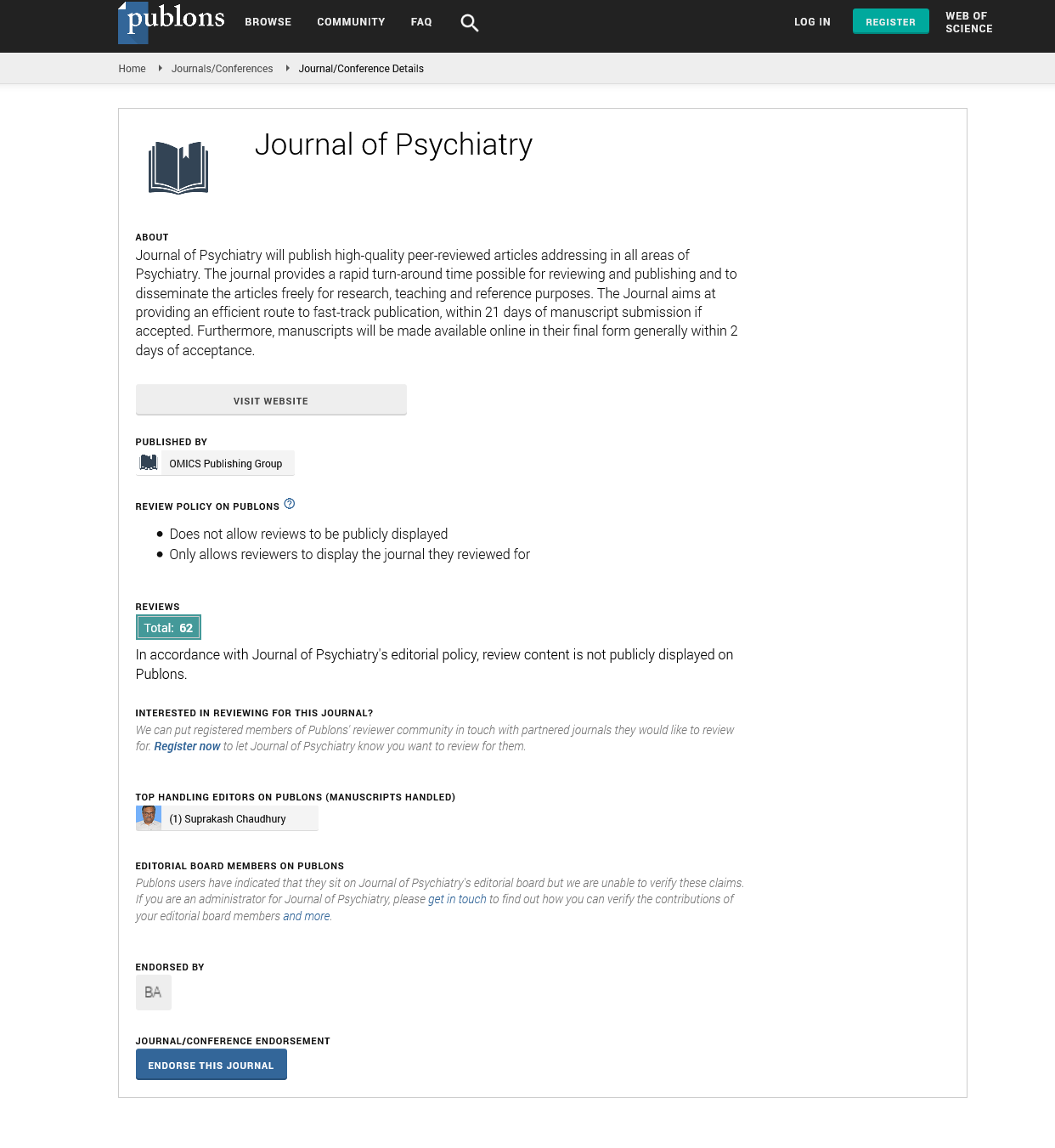Indexed In
- RefSeek
- Hamdard University
- EBSCO A-Z
- OCLC- WorldCat
- SWB online catalog
- Publons
- International committee of medical journals editors (ICMJE)
- Geneva Foundation for Medical Education and Research
Useful Links
Share This Page
Open Access Journals
- Agri and Aquaculture
- Biochemistry
- Bioinformatics & Systems Biology
- Business & Management
- Chemistry
- Clinical Sciences
- Engineering
- Food & Nutrition
- General Science
- Genetics & Molecular Biology
- Immunology & Microbiology
- Medical Sciences
- Neuroscience & Psychology
- Nursing & Health Care
- Pharmaceutical Sciences
Opinion - (2025) Volume 28, Issue 4
Emotional Suppression and Interpersonal Conflict in Patients with Generalized Anxiety Disorder
Zhang Mei*Received: 01-Jul-2025, Manuscript No. JOP-25-30177; Editor assigned: 03-Jul-2025, Pre QC No. JOP-25-30177; Reviewed: 17-Jul-2025, QC No. JOP-25-30177; Revised: 23-Jul-2025, Manuscript No. JOP-25-30177; Published: 31-Jul-2025, DOI: 10.35248/2378-5756.25.28.758
Description
Emotional expression is a vital component of human communication, particularly within close and intimate relationships. The ability to openly express feelings especially during moments of disagreement or stress facilitates connection, mutual understanding and conflict resolution. However, for individuals experiencing Generalized Anxiety Disorder (GAD), the habitual suppression of emotions may serve as a maladaptive coping strategy that contributes to interpersonal difficulties. Emotional suppression, while often aimed at reducing anxiety or avoiding perceived conflict, may paradoxically lead to greater relational tension misunderstandings and prolonged disputes. The present study aimed to explore the relationship between emotional suppression and interpersonal conflict in individuals with GAD compared to those without psychiatric diagnoses. Specifically, the research examined whether higher levels of emotional suppression during interpersonal disagreements were associated with increased frequency and severity of relational conflicts. The study also sought to understand how these patterns influence the quality and resolution of disputes in everyday life.
A total of 125 adults participated in the study, with 65 individuals formally diagnosed with Generalized Anxiety Disorder and 60 serving as healthy controls without any reported psychiatric conditions. Participants were recruited from outpatient clinics, university counselling centers and community advertisements. All participants completed a battery of validated self-report questionnaires assessing their tendencies toward emotional suppression and the frequency, intensity and duration of interpersonal conflicts. Data were collected over a four-week period using digital daily logs and weekly assessments to ensure ecological validity and minimize retrospective bias. The findings revealed a clear distinction between the two groups. Individuals with GAD reported significantly higher levels of emotional suppression particularly during moments of disagreement with close others such as romantic partners, family members or close friends. Suppression was defined as the deliberate inhibition of emotional expression, whether verbal or nonverbal in order to avoid confrontation, minimize discomfort or maintain perceived harmony.
In addition to higher suppression levels, participants with GAD also reported a greater number of relational conflicts over the four-week period. These conflicts were often described as lingering longer being more difficult to resolve and involving recurring themes of feeling misunderstood or emotionally disconnected. Statistical analysis showed that emotional suppression was significantly correlated with several negative relational outcomes, including increased conflict frequency, longer durations of disputes and delayed resolution. Importantly, these relationships remained significant even after controlling for baseline levels of trait anxiety and depressive symptoms, suggesting that emotional suppression itself may serve as an independent contributor to interpersonal dysfunction in GAD. Qualitative responses collected through open-ended survey items offered additional insight into the lived experiences of participants. Many individuals with GAD expressed a sense of emotional detachment during disagreements often describing themselves or feeling unable to communicate what they truly felt. Several also noted that their avoidance of emotional expression stemmed from fears of being judged, rejected or escalating the conflict. Ironically, this emotional withholding often led to the opposite outcome confusion, frustration or emotional distance from others.
These results highlight the potential role of emotional suppression as a key mechanism underlying the interpersonal difficulties commonly observed in individuals with GAD. While suppression may temporarily reduce anxiety or perceived risk, it appears to interfere with healthy communication, conflict resolution and emotional intimacy. The repeated use of suppression may also reinforce internal emotional distress by limiting opportunities for emotional validation and problem solving through interpersonal interaction. From a clinical perspective, these findings underscore the importance of addressing communication patterns and emotional expression in the treatment of Generalized Anxiety Disorder. Traditional Cognitive-Behavioral Therapy (CBT) for GAD focuses primarily on worry reduction and cognitive restructuring. However, therapy models that incorporate interpersonal and emotion focused components such as Emotion-Focused Therapy (EFT) or Inter Personal Therapy (IPT) may offer additional benefits for individuals whose anxiety is closely tied to relationship dynamics.
Helping clients recognize the function and consequences of emotional suppression could serve as a foundation for building healthier interpersonal habits. Therapeutic goals might include increasing emotional awareness developing skills for assertive communication and practicing vulnerability in safe relational contexts. Group therapy or couples-based interventions may also be useful for promoting mutual understanding and fostering supportive relationship dynamics. Future research would benefit from examining these patterns in more diverse samples and over longer durations. Longitudinal studies could help determine whether changes in emotional expression are associated with improved relationship functioning and reduced anxiety symptoms over time. Additionally, it would be valuable to explore cultural and gender-related factors that influence the use and impact of emotional suppression as norms surrounding emotional expression vary widely across different social contexts.
Citation: Mei Z (2025). Emotional Suppression and Interpersonal Conflict in Patients with Generalized Anxiety Disorder. 28:758.
Copyright: © 2025 Mei Z. This is an open-access article distributed under the terms of the Creative Commons Attribution License, which permits unrestricted use, distribution and reproduction in any medium, provided the original author and source are credited

